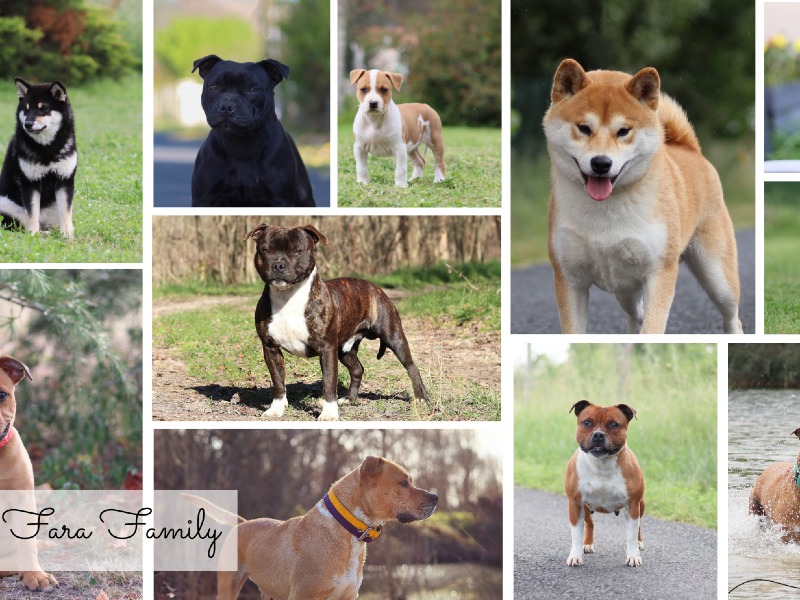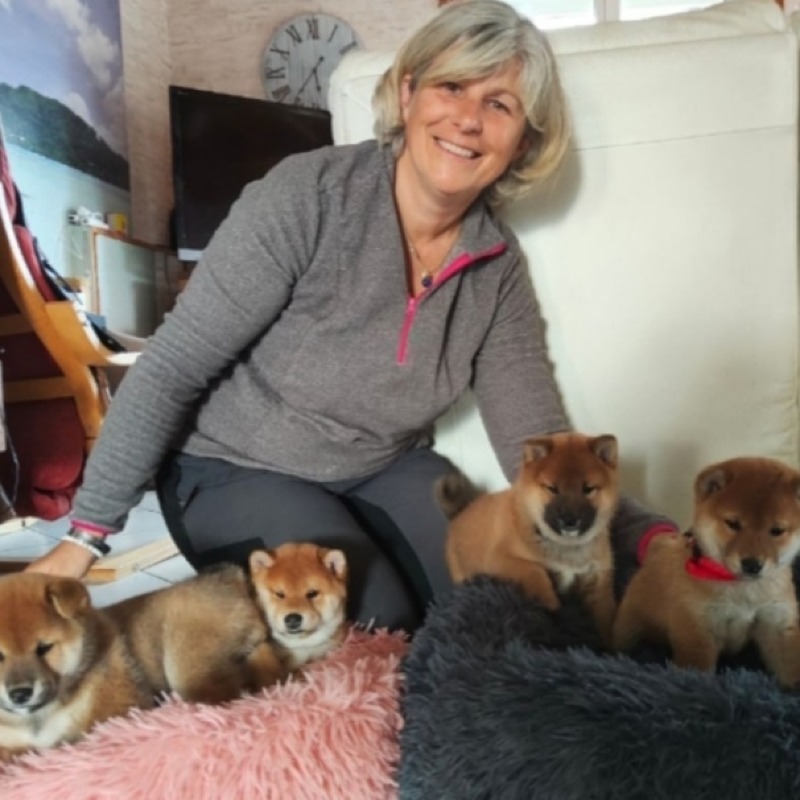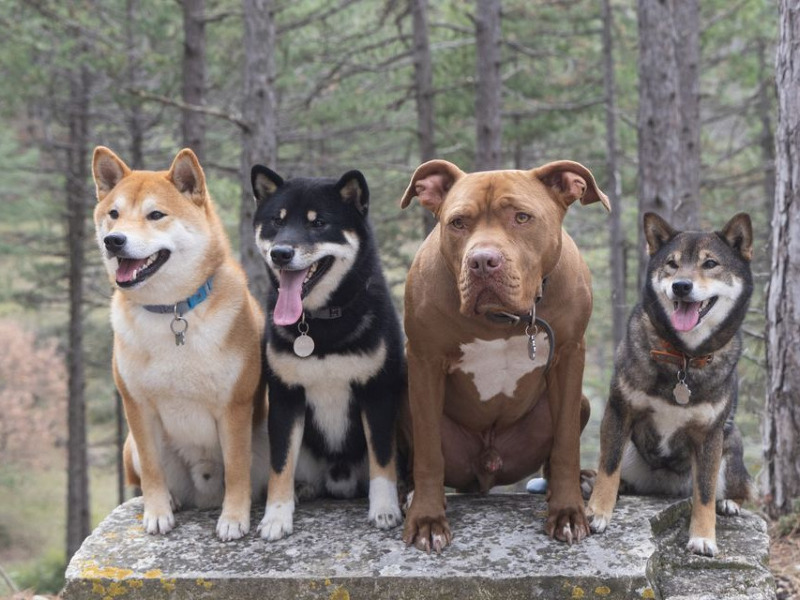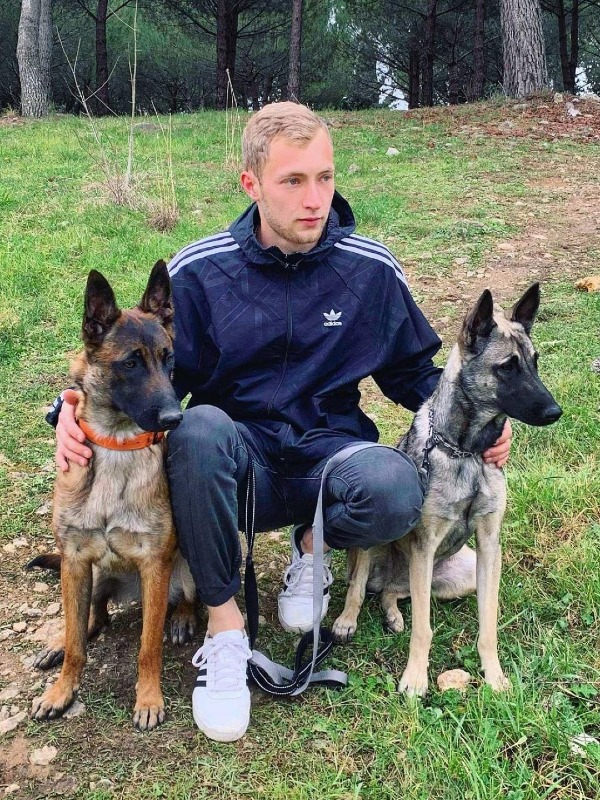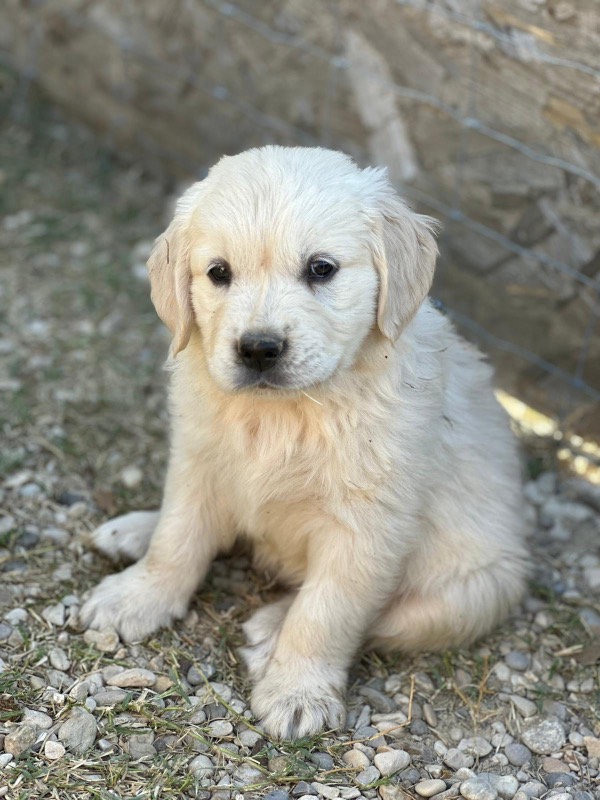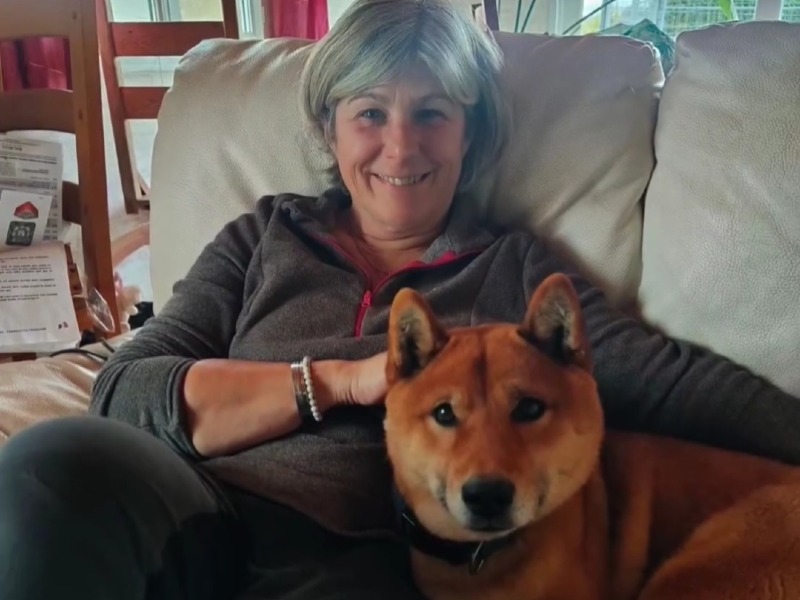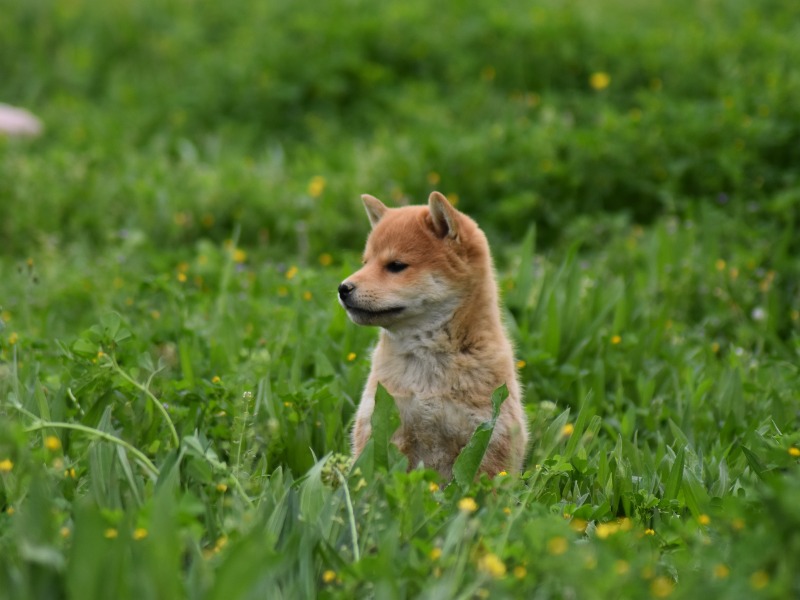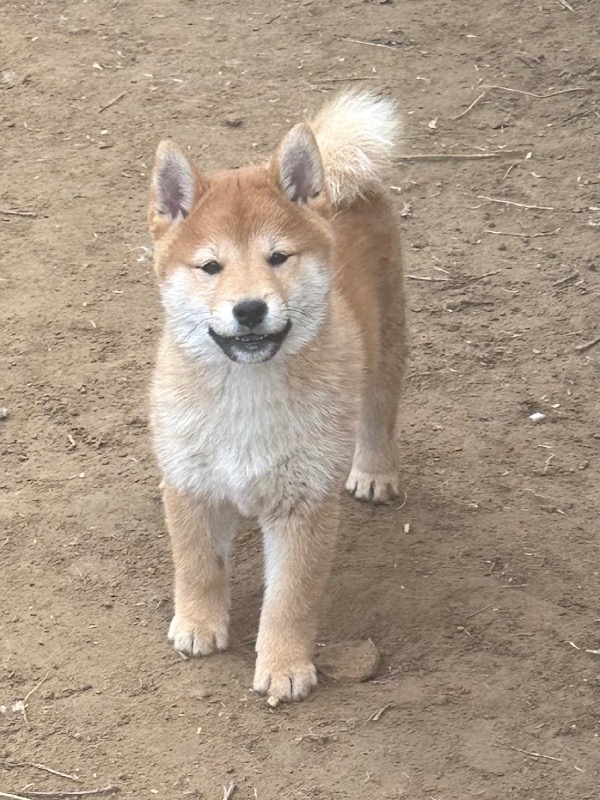Shiba-inu
Welcome to our page dedicated to the breed of dog shiba-inu!
Here, you will find all the useful information about shiba-inu. This descriptive profile will allow you to discover the aspects of this breed. You can notably consult information about the average price, monthly and annual upkeep expenses, their health, name ideas, as well as their official recognition by competent authorities.
Explore this page to discover everything you need to know.
Overall description of the breed
Originating from Japan, where it has a millennial presence, the Shiba Inu derives its name from the expression meaning "small size". It is primarily found in the mountainous regions of Japan, where it was used to hunt birds and small game.
This breed is highly regarded by the Japanese public, but it came close to disappearing. Between 1898 and 1912, new Western dog breeds like the Pointer and English Setter were imported to Japan, and some were crossed with the Shiba, leading to the dilution of pure bloodlines. Concerned breeders searched for and preserved the non-crossed specimens, thus enabling the restoration of the breed.
Thanks to these meticulous efforts, a breed standard was drafted and adopted in 1934. In 1936, the Japanese government classified the Shiba Inu as a national natural treasure to protect it. Consequently, the breed gained popularity as a companion dog rather than a working dog. Official recognition by the International Canine Federation occurred only 30 years later, on March 18, 1964, and its current standard was published on October 30, 2016.
The Shiba Inu is a small-sized dog, well-proportioned overall, with a robust build, strong bone structure, and well-developed musculature. Its height at the withers is roughly equal to its length, giving it a square silhouette. Its round head, broad skull, and well-pronounced jaws give it a teddy bear-like appearance.
Its muzzle is fine, of moderate length, and pointed, with a distinct stop. Its oval-shaped eyes are always brown in color. Its ears, of modest size and triangular shape, are erect and slightly inclined forward. The Shiba Inu proudly carries its tail above its back, forming a graceful arc, which is a distinctive feature. Its coat is short, pleasant to the touch, but with a firm and stiff texture, accompanied by a soft undercoat. Coat colors recognized by the breed standard are red and white, sesame, and black and tan.
Naturally wary, the Shiba Inu possesses a strong protective instinct towards its owners. It requires an adaptation period to grant trust to strangers. Despite appearing reserved or solitary, it is actually an affectionate companion deeply attached to its family. Additionally, it often forms a strong bond with a specific person, a common trait among spitz-type dogs. Always alert and attentive to its environment, the Shiba Inu is an active, playful, and sociable small dog, brimming with energy.
Regular physical activities are necessary to channel its energy when indoors, which is crucial for its physical and mental balance. Its training can be complex, but with discipline and patience, it acquires solid obedience skills. Intelligent and devoted, it quickly comprehends what you teach it.
However, despite its gentle teddy bear-like appearance, it has a dominant personality towards other dogs. Early socialization is thus essential to encourage harmonious interactions. It is never aggressive towards humans and is an ideal partner, affectionate towards children and attentive towards adults. The Shiba Inu's popularity is steadily growing year by year, and its qualities will undoubtedly enable it to win the hearts of many families!
In adulthood, the Shiba Inu generally weighs between 6 to 10 kg (13.2 to 22 lbs) and stands between 38 to 41 cm (15" to 16.1") at the withers for males, and between 35 to 38 cm (13.7" to 15") for females.
Awareness of acquiring an animal
Each animal is a sensitive being, deserving love, attention and care.
When you choose to adopt an animal, you take on the responsibility of ensuring its health and well-being throughout its life.
To learn more about animal welfare, we invite you to consult our FAQ by clicking the button below:
Origins
The Shiba Inu is a dog breed originating from Japan. Its name means "small dog" in Japanese, reflecting its compact size. This ancient breed, with origins dating back several thousand years, was originally used for hunting small game and birds in the mountainous regions of the country. The Shiba Inu shares its ancestors with other Japanese breeds such as the Akita Inu, Kishu, and Shikoku. This rugged and agile dog is perfectly adapted to rough terrains, making it an ideal companion for Japanese hunters. The first Shiba Inu were imported to the United States after World War II, and the breed has since gained popularity worldwide due to its charming appearance and independent nature.
History
The history of the Shiba Inu is closely linked to that of Japan, where it is considered a national treasure. The breed nearly disappeared in the early 20th century due to war and disease, but conservation efforts helped to save it. In 1928, the first breed standard was established, and in 1936, the Shiba Inu was designated as a Natural Monument by Japan. During World War II, the breed was once again threatened, but post-war breeding programs helped to revive it. Today, the Shiba Inu is one of the most popular dogs in Japan and is starting to gain recognition internationally due to its unique character and attractive appearance.
Standard
The Shiba Inu breed standard, as defined by canine organizations, describes a small, well-proportioned dog with a compact and muscular appearance. The height at the withers for males is approximately 39.5 cm and 36.5 cm for females, with a tolerance of plus or minus 1.5 cm. The Shiba Inu should have a well-proportioned head, small, triangular ears slightly tilted forward, and a thick tail curled over the back. The eyes are small, almond-shaped, dark in color, and express characteristic liveliness and vigilance. The coat is double, with a soft and dense undercoat and a straight and harsh topcoat. Accepted colors are red, sesame (red coat with black tips), black and tan, and white (cream).
Physical characteristics
The Shiba Inu is a small-sized dog, measuring about 39.5 cm for males and 36.5 cm for females, with a weight ranging from 8 to 10 kg. Its double coat consists of a soft and dense undercoat and a straight and harsh outer coat, providing good protection against the weather. The colors of the Shiba Inu can be red, black and tan, sesame, and cream. The muzzle is straight and tapered, the eyes are almond-shaped, and the ears are small, triangular, and erect. The tail is thick and curled over the back, adding to its distinctive appearance. Its silhouette is compact and muscular, allowing it to move with agility and speed.
Character
The Shiba Inu is known for its independent nature and strong temperament. Intelligent and curious, it is also very loyal to its masters, although it can sometimes be distant with strangers. This breed is known to be clean and tidy, often compared to a cat due to its grooming habits and reserved behavior. The Shiba Inu is also very vigilant, making it an excellent guard dog despite its small size. However, it can be stubborn and requires firm but gentle training from a young age. Although it is generally affectionate with its family, it also likes to have its own space and can be territorial.
Life expectancy
The Shiba Inu generally enjoys good health and has a relatively long lifespan for a dog of its size. On average, a Shiba Inu lives between 12 and 15 years, or even longer with proper care and a balanced diet. Some individuals can even surpass this age, especially if they have a healthy environment, plenty of exercise, and regular visits to the veterinarian. Like all breeds, they can be prone to certain genetic diseases, but preventive care and regular check-ups can help maintain their health and longevity.
Exercise and activity needs
The Shiba Inu is an active breed that needs a lot of exercise to stay physically and mentally healthy. He enjoys long walks, interactive games, and outdoor activities such as hiking. On average, it is recommended to provide him with at least one hour of exercise per day. The Shiba Inu is also very intelligent and benefits from mental stimulation in the form of puzzle games, training sessions, and socialization with other dogs. Without sufficient exercise, he can become destructive or develop undesirable behaviors. An enriching environment and a regular exercise routine are essential for his well-being.
Recommended diet
The feeding of the Shiba Inu should be balanced and adapted to its specific needs. It is advisable to choose a high-quality food, rich in proteins, with portions adjusted according to its weight, age, and activity level. In general, the monthly cost to feed a Shiba Inu is between 30 and 60 euros, depending on the brands of food and any potential supplements. Premium kibble is often preferred, but some owners opt for a mixed diet including wet or homemade food. It is important to monitor its weight and regularly consult a veterinarian to adjust its diet if necessary.
Training and obedience
The Shiba Inu can be a challenge to train due to its independent and sometimes stubborn nature. Early socialization and consistent, patient training are essential to make it a well-behaved companion. Positive reinforcement methods, based on rewards and encouragement, are particularly effective with this breed. Training sessions should be short and varied to maintain its interest. Consistency is key, as the Shiba Inu can easily develop bad habits if not corrected from the beginning. A good obedience program can help channel its energy and strengthen the bond between the dog and its owner.
Behavior with children
The Shiba Inu can be an excellent companion for children, especially if socialized with them from a young age. He is generally patient and tolerant, but supervision is necessary to prevent incidents. Children should be taught to respect the dog's space and signals. The Shiba Inu enjoys active games, which can make him a good playmate for children. However, due to his independent nature, he may sometimes prefer to withdraw to a quiet place. Good socialization and positive interaction from the beginning can promote a harmonious relationship.
Compatibility with Other Animals
The Shiba Inu can coexist with other pets, but it depends a lot on its socialization and training. In general, it gets along well with other dogs, especially if they are introduced gradually and positively. However, its hunting instinct can cause issues with small animals such as cats, rodents, or birds. Early and ongoing socialization is essential to minimize predatory behaviors. It is important to monitor initial interactions and ensure that all pets feel safe and comfortable in their shared environment.
Grooming needs
The Shiba Inu has a double coat that requires regular maintenance to keep it clean and healthy. Weekly brushing is sufficient in normal times, but during shedding periods, which occur twice a year, daily brushing is recommended to remove dead hair and prevent mats. Baths can be given occasionally, about every three months, or when the dog is particularly dirty. It is also important to regularly check and clean their ears, trim their nails, and monitor the condition of their teeth to prevent oral health problems.
Health
The Shiba Inu is a robust and generally healthy breed, but it can be prone to certain hereditary conditions such as hip dysplasia, luxating patella, and some eye diseases like glaucoma and cataracts. It is crucial to choose a responsible breeder who tests their breeding dogs for these conditions. Balanced nutrition, regular exercise, and annual veterinary check-ups are essential to maintain its health. Vaccinations and regular parasite treatments also help prevent diseases. With proper care, the Shiba Inu can live a long and healthy life.
Average price
The price of a Shiba Inu varies depending on several factors such as the reputation of the breeder, the quality of the parents, and the location. Generally, the average price of a Shiba Inu ranges between 1,500 and 3,000 euros. Dogs intended for shows or breeding can cost more, sometimes up to 4,000 euros. It is important to be wary of prices that are too low, often synonymous with unethical breeding or dogs from poor living conditions. Investing in a Shiba Inu from a reputable breeder guarantees a healthy, well-socialized dog that meets the breed standards.
Expenses
In addition to the initial purchase cost, Shiba Inu owners must budget for monthly expenses for their dog's care. Monthly costs can vary but typically range between 50 and 100 euros. This includes food, regular veterinary care, parasite treatments, grooming products, and accessories like toys and collars. Visits to the vet for vaccines and annual health check-ups, as well as potential pet insurance, can also add to expenses. Budgeting for these costs is essential to ensure the ongoing well-being of the Shiba Inu.
Name ideas
Naming a Shiba Inu can be a fun and creative task, reflecting your companion's unique personality. Here are some suggestions: Yuki, Hoshi, Sora, Kiko, Kumo, Riku, Akira, Taro, Mika, Niko, Hana, Toshi, Kira, Miko, Suki, Kuma, Rina, Kyo, Nara, Yumi. These names have Japanese sounds that honor the origins of the Shiba Inu and are easy to pronounce, which is important for clear communication with your dog. When choosing a name, it is essential to consider the personality and physical characteristics of your Shiba Inu. For example, an energetic and adventurous dog could carry the name "Riku" (which means earth or ground in Japanese), while a more calm and gentle dog could be called "Hana" (which means flower). Using short and distinct names also helps to capture your dog's attention more easily.
Legislation and regulation
In France, the Shiba Inu is not classified as a dangerous dog and therefore is not subject to specific restrictions like those imposed on category 1 and 2 dogs. However, owners must comply with general laws regarding dog ownership, such as registration with the town hall, mandatory rabies vaccination, and keeping the dog on a leash in public spaces. It is also recommended to take out liability insurance to cover any potential damages caused by the dog. Other countries may have different legislations, so it is important to check local laws before acquiring a Shiba Inu.
Official recognition
The Shiba Inu is recognized by several cynological organizations around the world. In France, it is registered in the Livre des Origines Français (LOF) under the Fédération Cynologique Internationale (FCI). In the United States, it is recognized by the American Kennel Club (AKC), and in the United Kingdom, by the Kennel Club (KC). The Japan Kennel Club (JKC) is the main organization in Japan, the country of origin of the Shiba Inu. These organizations establish breed standards and organize beauty and agility competitions to promote and preserve the characteristics of this breed.
Pedigrees
The pedigrees of Shiba Inu are available from several recognized breed clubs. In France, the Club du Shiba Inu en France (CSIF) is a reference for breeders and owners. In the United States, the National Shiba Club of America (NSCA) provides resources and information on the breed. In Japan, the Nihon Ken Hozonkai (NIPPO) is the main organization for the preservation of Japanese breeds, including the Shiba Inu. Other notable clubs include the Shiba Inu Club of Great Britain (SICGB) and the Shiba Inu Club of Canada (SICC), all dedicated to the promotion and protection of this unique breed.
Destination and usage
The Shiba Inu was originally a hunting dog, used to track small game and birds in the mountainous regions of Japan. Today, it is primarily valued as a companion dog due to its loyal and independent nature. Its vigilance and protective character also make it a good guard dog, despite its small size. The Shiba Inu excels in dog sports such as agility, obedience, and rally, which exploit its intelligence and natural agility. Its unique personality and attractive appearance make it a popular choice for families and individuals seeking a loyal and energetic companion.
Prohibitions
There are no specific prohibitions regarding the ownership of Shiba Inu in France, as they are not classified as dangerous dogs. However, owners must comply with local regulations regarding dogs in general, such as registration, vaccinations, and the use of a leash in public spaces. In some countries, there may be restrictions on importing dogs or specific rules for pet care. It is important to inquire about local laws and ensure compliance with all regulations before acquiring a Shiba Inu.
Breeders of Shiba-inu
Want to see more breeders of Shiba-inu?
Check out the page of our directory listing all breeders of Shiba-inuClassified Ads of Shiba-inu
Breed clubs of shiba-inu
No of shiba-inu breed clubs are currently registered on Preeders.
If you would like to highlight your breed club, sign up for free now and be the first to appear on this page.

